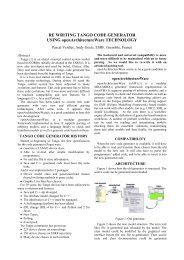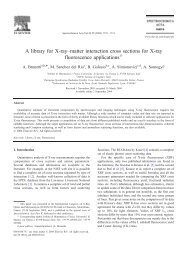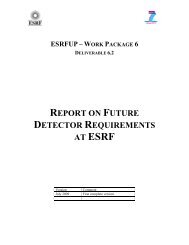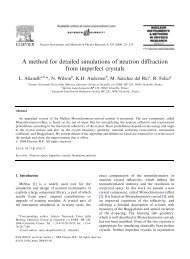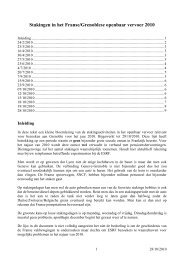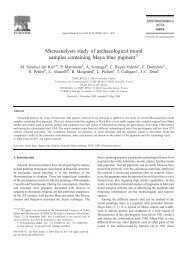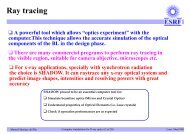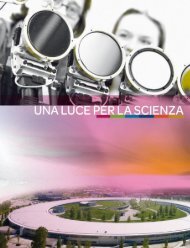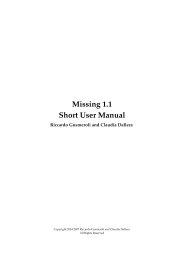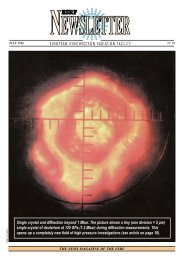New Scientific Opportunities at the European Synchrotron Radiation ...
New Scientific Opportunities at the European Synchrotron Radiation ...
New Scientific Opportunities at the European Synchrotron Radiation ...
You also want an ePaper? Increase the reach of your titles
YUMPU automatically turns print PDFs into web optimized ePapers that Google loves.
<strong>European</strong> <strong>Synchrotron</strong> Radi<strong>at</strong>ion Facility Long-Term Str<strong>at</strong>egy 7 July 2006<br />
Several high performance soft X-ray (E = 2 GeV) SR sources have been oper<strong>at</strong>ing<br />
for a number of years. Notable amongst <strong>the</strong>se are ALS, ELETTRA and BESSY, all of<br />
which have made very significant scientific advances across a wide range of<br />
disciplines. There have been striking advances in angular resolved photoemission<br />
with parallel detection which has allowed <strong>the</strong> study of Fermi surfaces in m<strong>at</strong>erials<br />
with unprecedented detail and d<strong>at</strong>a acquisition r<strong>at</strong>es. The intensity of <strong>the</strong>se soft x-ray<br />
sources, coupled with innov<strong>at</strong>ive photon and electron optics, has opened <strong>the</strong> p<strong>at</strong>h to<br />
new, non-destructive, chemical species and magnetic <strong>at</strong>om selective microscopies,<br />
which in some cases push sp<strong>at</strong>ial resolution to <strong>the</strong> nanometer level. Whilst <strong>the</strong>re is<br />
some overlap with activities <strong>at</strong> <strong>the</strong> ESRF, notably in areas of research carried out <strong>at</strong><br />
<strong>the</strong> ID08 soft X-ray beamline, this work is largely complementary to ESRF studies.<br />
At <strong>the</strong> o<strong>the</strong>r end of <strong>the</strong> X-ray spectrum, th<strong>at</strong> of hard X-rays (say E > 50 keV), <strong>the</strong> only<br />
<strong>European</strong> source which can rival <strong>the</strong> ESRF’s performance will be PETRA-III, to be<br />
oper<strong>at</strong>ional from 2009 (<strong>at</strong> which time <strong>the</strong> DORIS facility may become unavailable).<br />
The small number of beamlines (some 9 have been proposed so far) and <strong>the</strong> large<br />
demand from <strong>the</strong> German n<strong>at</strong>ional community will result in only a minor impact on<br />
ESRF usage.<br />
The most direct impact on <strong>the</strong> ESRF can be expected from <strong>the</strong> new medium-energy<br />
sources (SLS, Soleil, Diamond and ALBA). It is however interesting to note th<strong>at</strong> <strong>the</strong><br />
start-up of <strong>the</strong> Swiss Light Source has only led to a slight decrease in usage of <strong>the</strong><br />
ESRF by <strong>the</strong> Swiss SR community; <strong>the</strong> return coefficient for scientific use remains<br />
close to 1. It is clear th<strong>at</strong> <strong>the</strong> demand for <strong>the</strong> ESRF’s protein/macromolecular<br />
crystallography (PX/MX) beamlines for more routine experiments will decline,<br />
especially from <strong>the</strong> UK biology community as <strong>the</strong>y move to exploit <strong>the</strong> new Diamond<br />
PX/MX beamlines (three are planned for <strong>the</strong> initial phase of Diamond’s oper<strong>at</strong>ion).<br />
However it is reasonable to expect th<strong>at</strong> several years of test and development will be<br />
needed before <strong>the</strong> Diamond (or Soleil, or ALBA) beamlines can rival those <strong>at</strong> <strong>the</strong><br />
ESRF in terms of reliability, stability and throughput. With less demand for <strong>the</strong> more<br />
routine projects <strong>the</strong> ESRF will be able to give more beamtime to <strong>the</strong> more advanced<br />
biological projects such as protein complexes and membrane proteins th<strong>at</strong> often<br />
require screening thousands of crystals. This procedure has been gre<strong>at</strong>ly facilit<strong>at</strong>ed<br />
by <strong>the</strong> autom<strong>at</strong>ion of <strong>the</strong> ESRF’s MX beamlines equipped with large detectors.<br />
While Diamond and similar synchrotrons will have very high brilliance for X-ray<br />
energies up to <strong>at</strong> least 20 keV, a consider<strong>at</strong>ion of all factors governing <strong>the</strong><br />
experimental signal strength (beamline divergences, apertures, etc) leads to <strong>the</strong><br />
conclusion th<strong>at</strong> <strong>the</strong> cross-over energy where ESRF beamlines become superior is<br />
rel<strong>at</strong>ively low, and is calcul<strong>at</strong>ed to lie below 10 keV.<br />
Where <strong>the</strong> various free-electron laser projects are concerned, <strong>the</strong> impact on <strong>the</strong><br />
ESRF is expected to be even less direct. The very low energy sources already<br />
oper<strong>at</strong>ing (e.g. FELIX oper<strong>at</strong>es in <strong>the</strong> infra-red and far-infra-red) provide experimental<br />
facilities for <strong>at</strong>omic and molecular spectroscopies and have strong programmes in<br />
biological fields (e.g. bio-medicine) in energy regimes far from those of <strong>the</strong> ESRF.<br />
The field of linear acceler<strong>at</strong>or based FEL facilities is evolving rapidly thanks to<br />
demonstr<strong>at</strong>ions of <strong>the</strong> SASE concept in <strong>the</strong> visible and VUV region. This progress is<br />
exemplified by <strong>the</strong> successful oper<strong>at</strong>ion of <strong>the</strong> VUV FEL (FLASH) <strong>at</strong> DESY which is<br />
opening up new and exciting fields of science on ultra-short time scales. The<br />
ambitious soft X-ray and X-ray projects such as FERMI <strong>at</strong> ELETTRA and <strong>the</strong><br />
<strong>European</strong> X-FEL <strong>at</strong> DESY are several years away from routine oper<strong>at</strong>ion. Similar<br />
6



